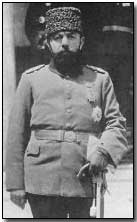Battles - The Defence of the Suez Canal, 1915
 1915 saw the
ever-escalating First World War spread to Egypt and Palestine. Sited
in the region was the all-important Suez Canal, controlled by the British.
1915 saw the
ever-escalating First World War spread to Egypt and Palestine. Sited
in the region was the all-important Suez Canal, controlled by the British.
Completed in 1869 and running north-south across the Suez Isthmus in Egypt to the Mediterranean in the Red Sea, its importance lay in its status as the quickest naval route between Europe and the countries around the Indian and western Pacific oceans: in short, between Britain and her colonies.
Such was the background to the coming conflict. The Turkish Minister of Marine, Djemal Pasha, together with his German Chief of Staff Kress von Kressenstein, led an expedition on 14 January 1915 across the Sinai Peninsula from Beersheba - the Suez Expeditionary Force of 25,000 men - aimed at surprising the British and seizing control of the canal. Chief responsibility in both planning and execution lay with Kressenstein with Djemal as the expedition's figurehead.
Somewhat inconveniently for the Turks, an assault upon the canal proved impossible by road or rail. Access to the canal was only possible via a 300km march across the desert from Beersheba.
Before this could be seriously considered however a supply chain (which necessarily included water) needed to be strung across the line of march. Furthermore the march itself could only be contemplated during the region's brief rainy season.
Thus the entire mission needed to be completed within just two months; and once at the canal the Turks had just four days in which to seize control before returning for supplies, especially water. While Djemal intended to concentrate his attack at Ismailia he hoped to confuse the defence effort by launching diversionary attacks all along the canal.
The British themselves had feared an attack since the outbreak of war in August 1914 - with good reason, for Djemal began planning its capture from the very first - but had placed its defence as a secondary consideration to the war being fought on the Western Front.
Nevertheless some 30,000 Indian army troops were belatedly applied to the canal's defence once Turkey's intention to enter the war on the side of the Central Powers became clear. An Anglo-French naval squadron was added to the defence force, as was a small air reconnaissance force.
The focus of the defence effort was the railway junction at Ismailia, in the centre of the canal, and a clear target for attack. However defence forces were established throughout the 150km length of the canal.
With the Turkish expedition heavily reliant upon total surprise for any possibility of success, the British were nevertheless warned of impending attack by reconnaissance aircraft on 1 February.
Accordingly, when on 2 February advance elements of the Ottoman Fourth Army reached the canal and began the assault they were met and beaten back by an Indian force, subsequently reinforced by Australian infantry.
Djemal persisted with his assault until 3 February but after losing some 2,000 casualties (to the British 150) authorised a full retreat back to Beersheba. The expedition a failure - and the only Turkish attempt of the war to capture the canal - Djemal's reputation suffered grave damage.
Kressenstein was more fortunate. Assigned to command of the defence of the garrison at Gaza he successfully fought off two British attempts led by Sir Archibald Murray to take Gaza in March and April 1915, before finally succumbing to a third assault led by new British Commander-in-Chief Sir Edmund Allenby.
Although the Turks never again attempted to seize control of the Suez they did however succeed in tying up an inordinately large British defence intended to protect the canal against future expeditions. This British force could (and would) have been placed to better use for the Dardanelles campaign; its absence therefore contributed to the Allies' disastrous failure at Gallipoli.
Click here to view a map of pre-war Palestine and Mesopotamia.
Photograph courtesy of Photos of the Great War website
"Monkey meat" was U.S. slang for the canned beef and carrot ration.
- Did you know?
